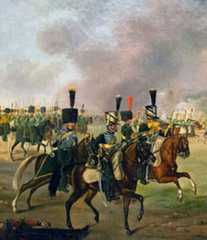Battle of Toulouse
The Battle fought by Wellington againstMarshal Soult on 10th April 1814 outside the French City of Toulousein Southern France; the last battle fought by Wellington in the Peninsular War

50.Podcast on theBattle of Toulousefought on 10th April 1814 by Wellington against Marshal Soult outside the French City of Toulouse in Southern France; the last battle fought by Wellington in the Peninsular War:John Mackenzie’s britishbattles.com podcasts
The previous battle of the Peninsular War isthe Battle of Tarbes
The next battle of the Peninsular War isthe Sortie from Bayonne

War: PeninsularWar
Dateof the Battle of Toulouse: 10th April 1814
Placeof the Battle of Toulouse: Toulousein South-Western France.
Combatantsat the Battle of Toulouse: British,Portuguese and Spanish troops against the French.
Commanders at the Battle of Toulouse: Marquess of Wellington against the French commander, Marshal Soult.
Size of the armies at the Battle of Toulouse:
Soult’sFrench Army of the Peninsular comprised 25,000 infantry, 1,000 cavalry and 38guns.
Theforce available to Wellington in the advance on Toulouse comprised 50,000 men.
Winnerof the Battle of Toulouse:
Thebattle ended with Marshal Soult marching his army out of Toulouse, to join thearmy of Marshal Suchet at Carcassonne.
Fortescuecommented:‘…. It may freely be confessed that this was the mostunsatisfactory action that Wellington ever fought, and the worst managed’.
Orders ofBattle:
British,Portuguese and Spanish:
Fane’sBrigade: 13th and 14th Light Dragoons.
Ponsonby’s Brigade: 5th Dragoon Guards and 3rd and 4th Dragoons.
Arentschild’sBrigade: 1st and 2nd Dragoons, King’s German Legion.
Somerset’s HussarBrigade: 7th, 10th and 15th Hussars.
Vivian’sBrigade: 18th Hussars and 1st Hussars, King’s GermanLegion.
SecondDivision (Hill): Barnes’ Brigade: 1st/50th, 1st/71st,1st/92nd, 1 Co 5th/60th. Byng’sBrigade: 1st/3rd, 1st/57th, Prov Bn2nd/31st & 1st/66th, 1 Co 5th/60th.Pringle’s Brigade: 1st/28th, 2nd/34th,1st/39th, 1 Co 5th/60th. Harding’sBrigade: Portuguese 6th, 18th Line, 6th Caçadores.
ThirdDivision (Picton): Brisbane’s Brigade: 1st/45th, 74th,1st/88th, 4 Cos 5th/60th. Keane’sBrigade: 1st/5th, 2nd/83rd, 2nd/87th,94th. Power’s Brigade: Portuguese 9th, 12thLine, 11th Caçadores.
FourthDivision (Cole): Anson’s Brigade: 3rd/27th, 1st/40th,1st/48th, Prov Bn of 2nd Queen’s, 2nd/53rd.1 Co Brunswick-Oels. Vasconcellos’ Brigade: Portuguese 11th, 23rdLine, 7th Caçadores.
SixthDivision (Clinton): Pack’s Brigade: 1st/42nd, 1st/79th,1st/91st, 1 Co 5th/60th. Lambert’sBrigade: 1st/32nd, 1st/36th, 1st/61st.Douglas’s Brigade: Portuguese 8th, 12th Line, 9thCaçadores.
LightDivision (Alten): Kempt’s Brigade: 1st/43rd, 1st/95th,3rd/95th. Colborne’s Brigade: 1st/52nd,2nd/95th. Portuguese 17th Line, 1st,3rd Caçadores.
SpanishDivision (Freire)
Morillo’sSpanish Brigade
French:
Corps:Reille’s, D’Erlon’s and Clausel’s.
Divisions: PierreSoult’s Dragoons, Maransin’s Division, Darmagnac’s Division, Harispe’s Division,Taupin’s Division, Vilatte’s Division, Darricau’s Division and Travot’s ReserveDivision:
Background to the Battle of Toulouse:

Following the defeat ofhis Army of the Pyrenees at the Battles of Orthez on 2nd February1814 and at Tarbes on 20th March 1814, Marshal Soult retreated in anorth-easterly direction on the city of Toulouse.
Soult took the roadthrough St. Gaudens, sacrificing order for speed.
Marching north along theleft bank of the River Garonne from St. Gaudens, Soult’s army reached Toulouseon 23rd March 1814. Discipline in the French army was breaking downand many of the French infantry were without shoes.
On 26th March1814, Wellington’s British, Spanish and Portuguese army reached Toulouse,causing the French to withdraw inside the city’s fortifications.
Clausel’s 2 divisionsoccupied the eastern suburb of St Etienne.
Pierre Soult’s cavalrydivision crossed the Garonne River and took up positions along the right bankfor 15 miles.
Reille’s Corps of 2divisions occupied the suburb of St. Cyprien on the left bank.
D’Erlon’s corps remainedoutside the western defences, at a distance of around 2 miles.
On 27th March1814, Wellington advanced and drove the French formations inside the defensivering of Toulouse.
On that evening, theBritish pontoon train moved up to the River Garonne, but was unable toestablish a bridge, there being insufficient pontoons for such a wide river.
On 28th March1814, Wellington made new dispositions, with Hill’s Corps positioned to thesouth-west of Toulouse, preparatory to a further bridging attempt.
Soult appeared satisfiedwith remaining inside the city’s defences and from there repelling any attackWellington might make, rather than taking the initiative.
On 30th and 31stMarch 1814, Hill’s Corps crossed the River Garonne at Pinsaguel, 5 milesupstream from Toulouse.
From the crossing, Hillmarched to the east in an attempt to find a way across to the road to Toulousefrom the south-east.
Hill was unable to findsuch a route and, on 1st April 1814, crossed back to the left bankof the River Garonne.
Soult made no effort tointerfere with Hill’s march.
By 2nd April1814, Soult was convinced that Wellington would cross the River Garonne to thenorth of Toulouse and launch his attack on the city from that direction.
Soult orderedentrenchments to be dug along the Heights of Calvinet, stretching down theeastern side of Toulouse, between the city and the River Hers.
In addition, Soultordered the construction of an abatis along the road to Albi from the RiverHers to the Mamelon de la Pujade.
Soult brought 6 of thedivisions in St Cyprien across the River Garonne to hold the line that followedthe Canal from the Garonne to the Matabiau Bridge and then to the River Hers onthe Albi road.
1 division remained in StCyprien to repel any assault by the British on that side of the Garonne.
Battleof Toulouse:
On the night of 4thApril 1814, Wellington’s pontoon bridge was laid across the River Garonne at apoint 12 miles north of Toulouse.
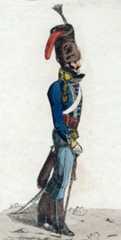
During 5thApril 1814, the British Third, Fourth and Sixth Divisions of infantry withSomerset’s, Ponsonby’s and Vivian’s cavalry brigades and 3 batteries ofartillery crossed by the pontoon bridge to the east bank of the River Garonne,preparatory to attacking the French positions along the canal.
By the evening, 20,000men under Beresford were on the east bank of the River Garonne.
Rain fell heavily thatnight forcing the removal of the pontoon bridge, to prevent it being sweptaway.
The rain continued tofall heavily, with intermittent gaps, preventing the use of the pontoon bridgeuntil 8th April 1814, when the pontoons were re-positioned acrossthe river.
On 8th April1814, Arentschild’s Cavalry Brigade and Freire’s Spanish Division crossed theRiver Garonne.
From there, Wellington’stroops advanced around the north of Toulouse, Picton’s Division and Freire’sSpanish Division turning directly towards the city, while Beresford’s Corps,comprising Clinton’s Sixth Division and Cole’s Fourth Division, marched southin 2 columns, between the Heights of Calvinet, occupied by the French garrisonand the River Hers, their orders being to approach Toulouse from thesouth-east, once they had outflanked the French entrenchments on the Heights ofCalvinet.
Wellington’s plan was toseize 3 bridges along the River Hers to facilitate the assault on the Heightsof Calvinet.
Pierre Soult’s DragoonDivision retired before the cavalry on the eastern flank of the Sixth andFourth Divisions, advancing south, parallel to the River Hers.
Vial’s French cavalrybrigade halted on the eastern side of the bridge at Croix Daurade, on the Albiroad, protecting the north-eastern flank of the defences stretching to LaPujade.
Theaction of the 18th Hussars:
The British 18thHussars came up on the eastern flank of Wellington’s advancing columns.
The 18th drovethe French cavalry piquets from the village of St Loup, 3 miles from the CroixDaurade bridge and across the River Hers.
This was other than theFrench 5th Chasseurs à Cheval, which moved onto a flank and openedcarbine fire on the 18th.
Wellington and Beresforddirected Colonel Hussey Vivian, commanding the cavalry brigade, to capture thebridge across the River Hers at Croix Daurade.
Hussey rode towards thebridge and was confronted by a mass of French cavalry on the far side of the river,moving forward unsupported by infantry or guns.
At this point Hussey wasstruck in the arm by a carbine round.
Hussey ordered the 18thHussars to attack the French dragoons advancing on the bridge. He raised hissword arm to signal the charge, but the bone struck by the carbine bulletsnapped and Hussey fell from his saddle in a faint.
Major Hughes led the 18thHussars in the charge, meeting the French cavalry on the bridge.
The French were driven backand retired in disorder, pursued by the 18th, which took 120 Frenchcavalrymen prisoners with their horses.
Pierre Soult, the generalcommanding the French dragoon division, was nearly captured.
The pursuit continueduntil the French dragoons were able to rally under the covering fire of theirguns.
Wellington called out‘Welldone the Eighteenth; by God, well done’.
The 18thHussars’ attack took place at 5pm and marked the end of the day’s action.
The British FourthDivision was now in possession of the bridge over the River Hers at CroixDaurade, while the French held the two bridges over the River Hers furthersouth, on the road to Lavaur, level with the centre of Toulouse and on the roadto Caraman, to the south-east of the city.
These other two bridgeswere either broken or prepared for destruction.

Wellington ordered thatthe assault on the Toulouse defences begin on the next day, 8thApril 1814.
The pontoon bridge was tobe moved 4 miles up-river to permit the Light Division to cross to the eastbank of the River Garonne. This move was not completed in time and the attackwas deferred to the 10th April 1814.

In the meantime, cavalryfrom Ponsonby’s and Vivian’s brigades were deployed in the rear, to guardagainst intervention by the French garrison in Montauban, 20 miles north ofToulouse.
TheFrench positions around Toulouse:
Clausel commanded theFrench positions along the Heights of Calvinet, running along the city’seastern side between the Languedoc Canal and the River Hers.
This was the scene forthe main British attack.
D’Erlon’s Corps held thesection of the Languedoc Canal running along the northern perimeter of Toulouseto the River Garonne; Darricau’s Division positioned along the canal bank withDarmagnac’s Division holding the area outside the Bridge of Matabiau at the right-handend, where the canal turned south to run along the eastern side of the city.
Maransin’s Division fromReille’s Corps remained in St Cyprien, the suburb to the south-west ofToulouse, on the western bank of the River Garonne.
Taupin’s Division stoodon the eastern bank of the River Garonne at the southern end of the Heights ofCalvinet, in support of Clausel.
Travot’s reserve divisionwas distributed at the north-eastern corner of the defences and along the RiverGaronne.
Wellington’sAttack on 10th April 1814:
Wellington planned for 2attacks on the French positions around Toulouse.
The main attack was to beconducted by Beresford, with Cole’s Fourth Division, Clinton’s Sixth Divisionand the Hussar Brigade, against the south-east corner of the French defences.
This attack required anapproach march down the length of the River Hers, parallel to the Frenchpositions on the Heights of Calvinet.
The second attack was allottedto Freire’s Spanish Division, advancing down the Albi road in columns on eitherside of the road.
Freire was required tohalt in the village of La Pujade, until Beresford began his attack and thenadvance and storm the Great Redoubt positioned at the northern end of theHeights of Calvinet.
In support of these 2assaults, Hill was to demonstrate against the suburb of St Cyprien on thewestern bank of the River Garonne and Picton and Alten were to conduct feintattacks along the line of the Languedoc Canal on the northern face of thedefences.
Wellington’s attack beganat 3am on Easter Sunday, 10th April 1814.
The Light Divisioncrossed the River Garonne, while the other formations began their march towardsthe north-east corner of the defences.
Vivian’s Brigade of the18th Hussars and the 1st Hussars of the KGL, commanded,in the absence of the wounded Vivian, by Major von Grüben, advancedaggressively down the east bank of the River Hers, pushing Berton’s dragoonbrigade before them.
The French managed todestroy the bridge on the Lavaur Road, directly east of Toulouse, but, headedby Captain Schaumann’s squadron, the hussars crossed the bridge on the Revalroad, well to the south-east of the Heights of Calvinet and chased the Frenchcavalry as far as the Pont des Demoiselles, behind the right flank of theCalvinet positions.
By 8am, Vivian’s brigadewas pressing in on the French defences.
Between 8am and 9am, Hillbegan his move against Maransin’s Division in St Cyprien, on the west bank ofthe River Garonne.
The battalion holding thenorthern point of the French line gave way and Hill was able to occupy itsposition and open cannon fire on the French troops holding the Jumeaux bridgeon the far bank.
This success enabled Hillto push Maransin’s men back into the suburb, before halting.
On the east bank,opposite the northern line held by the French, Picton advanced and took amansion house called le Petit Gragnague, in front of the Jumeaux bridges.
On Picton’s flank, Altenadvanced against the bridge of Minimes, while his second brigade moved east tosupport Freire’s attack.
In front of the Spanishadvance, Somerset’s cavalry brigade cleared Pierre Soult’s dragoons away, whileFreire occupied the knoll of La Pujade, abandoned by St Pol’s Division.
Freire’s guns opened acannonade on the French positions around the Great Redoubt, held by Vilatte’sDivision.
Wellington himself tookpost on the knoll of La Pujade to follow the progress of his attack.
Beresford’s Corps, comprisingCole’s Fourth and Clinton’s Sixth Divisions, reached Croix Daurade, where abridge crossed the River Hers, soon after 7am and began the hurried march southin 3 columns on the west bank of the River Hers, the infantry moving at thedouble.
The column on the rightcame under the direct fire of French cannon in the positions on the Heights of Calvinet,
The ground was difficult,due to the extensive heavy rain over the previous days and the British guns fellfar behind, finally halting at Mont Blanc.
Soult, watching from theHeights, expected Beresford to wheel and storm the Heights of Calvinet.
As Beresford’s columnshurried on past the obvious point of attack, it became clear to Soult thatBeresford was intending to march round his right flank.
Taupin was ordered to movehis division from the northern end of the Heights of Calvinet to the CaramanRoad, to block Beresford’s advance.
At around this time,11am, Freire, who was under orders to await Beresford’s attack before beginninghis own, lost patience and launched his own assault.
One Spanish columnadvanced down the Albi road, while the other, led by Freire, attacked the GreatRedoubt on his left.
Freire’s men were met byheavy cannon fire from the bridge of Matabiau and the city walls, beforespreading out to envelope the Great Redoubt.
At this point 2 Frenchregiments from Darmagnac’s Division emerged from an area of gardens and mounteda counter-attack on both Spanish columns.
The Spanish, taken bysurprise, fell back, their right-wing taking cover in a hollow road, which wasraked by artillery fire from the guns on the city walls.
The Spanish resumed theirretreat, in disorder, back to the village of La Pujade.
Wellington, observing themarch of Taupin’s Division to the southern end of the Heights of Calvinet, sentorders to Beresford to wheel to his right and begin his attack directly on theHeights, as Soult initially expected.
However, Beresford, formingthe view, as he marched south, that Wellington’s initial plan was entirelyappropriate for the French dispositions, in spite of the move by Taupin’s Division,ignored this order and continued to march to the southern end of the Heights ofCalvinet, after an initial deployment to his right in case the attack on Freirewas the beginning of a counter attack along the whole French line.

As the French did not stirfrom the Heights, Beresford soon resumed his march to the south.
For the next few hours,Wellington was concerned with halting the Spanish retreat and reforming the Spanishregiments.
Fortunately for Wellington,Soult made no attempt to follow up the French success in routing theimperfectly disciplined Spanish infantry.
However, Beresford wasleft to make his attack alone, without the benefit of being part of a doubleattack.
At around middayBeresford’s columns reached the Caraman road, wheeled to the right and deployedinto three lines.
Pack’s Brigade andWilliam Anson’s Brigade formed the first line. Lambert’s Brigade and Ross’sBrigade formed the second line. Douglas’s and Vasconcello’s Portuguese Brigadesformed the third line.
The front of Beresford’scolumns had outmarched the rest of the troops and it took some time for therear formations to catch up and take their places in the lines.

The French 21stChasseurs à Cheval advanced to threaten Beresford’s unformed right flank.
The provisional battalionfrom Cole’s Fourth Division, comprising companies from the Queen’s 2ndRegiment and 2nd/53rd moved out to block the Frenchcavalry.
Clinton’s Sixth Division came up and formed in line without pausing, enabling the whole of Beresford’s Corps to move forward to the attack.
The wet and muddyconditions prevented Beresford’s artillery from coming up and joining theadvance, remaining at Mont Blanc.
In the hour beforeBeresford’s Corps arrived and formed line, Soult had been putting Taupin’sDivision in a defensive posture, one brigade on each side of la Sypière Redoubt,Rey’s Brigade to the south and Gasquet’s Brigade to the north.
On the left flank, the 21stChasseurs à Cheval were posted and on the right flank, 6 squadrons fromBerton’s cavalry brigade with a battery of artillery.
The whole of the Frenchline was positioned behind the brow of the hill.
As Beresford’s Corps cameinto view over the brow of the hill, Soult is reported as calling out‘Herethey are, General Taupin; I make you a present of them.’
Taupin took command ofRey’s Brigade and led it in the attack on Beresford’s forming left wing.
Once in front of the la SypièreRedoubt, Taupin halted his advance and gave the command to deploy.

In answer a Britishrocket troop (a newly deployed weapon) fired a number of rockets into theFrench ranks, while Lambert’s and Anson’s Brigades opened a heavy fire on Rey’smen, in which Taupin fell, mortally wounded.
Rey’s Brigade retreatedin confusion to the crest of the hill. The British 61st Regimentattacked la Sypière Redoubt, causing the battalion holding the redoubt toabandon its position.
On the left flank ofTaupin’s Division, Gasquet’s Brigade fell back towards the suburb of St.Etienne, before the advance of the light companies from Clinton’s SixthDivision.
Attacks on the SixthDivision’s flank by the 21st Chasseurs à Cheval were held off by the79th Highlanders in square.
On the edges of StEtienne, Taupin’s artillery joined the retreating infantry brigades and a newFrench line was formed, with Leseur’s Brigade from Darmagnac’s Division andRouget’s Brigade from Maransin’s Division, along the east bank of the LanguedocCanal from St Etienne to the Pont des Demoiselles.
In spite of his success,Beresford, aware of the failure of the Spanish assault on the north-easterlydefences, did not press his attack further, halting to await the arrival of hisbogged-down guns.
Clinton’s Sixth Divisionhalted on the Lavaur road, with Cole’s Fourth Division on its left, flanked bySomerset’s and Vivian’s cavalry brigades.
The firing died away andaction ceased for a time.
Noting the lack ofaction, Picton, facing the Ponts Jumeaux from the Petit Gragnague, at the junctionof the Languedoc Canal and the River Garonne, at the north-west corner of thedefences of Toulouse, decided to convert his feint attack into a full assaulton the French positions.
Brisbane’s Brigade,supported by Power’s Portuguese Brigade, attacked the French bridge-head at thePonts Jumeaux.
Three times Picton’stroops pressed their attack, to be repelled with heavy casualties.
While Beresford’s andPicton’s attacks were taking place, Wellington was supervising the halt of theSpanish retreat and rallying and reforming the Spanish regiments.
Wellington then directedthat his original plan of a co-ordinated attack by Beresford and Freire be re-launched.
There was some delaywhile the Portuguese guns on the knoll of La Pujade were re-stocked withammunition and Beresford’s artillery came up the muddied road from Mont Blanc,before Freire’s men moved forward.

The Spanish attack wasagain unsuccessful, although pressed with energy.
Wellington refrained fromcommitting the Light Division in support of the Spanish, as it was his lastmajor unit and his only reserve.
Beresford’s attack fromthe Lavaur road on the French redoubts was led by the 42nd and the79th Regiments, both Highland, supported by another Highlandregiment, the 91st and the 12th Portuguese.
Commanded by ColonelMacara, later killed at Quatre Bras, who ordered‘Forward, double quick’,the 42nd drove Harispe’s division out of the Mas des Augustins, theredoubt at the corner of the French position.
The 79th stormedthe neighbouring Calvinet redoubt.
Harispe counter-attackedwith the 115th, 34th and 81st Regiments anddrove the 2 Highland regiments from their prizes.
The 79thrallied and returned to the attack, re-taking both redoubts.
The French again capturedthe redoubts, but were finally driven back once Lambert’s Brigade joined the assault,the French troops losing heart on the wounding of General Harispe and hisdeputy GeneralBaurot, who was shot in the right leg, losing the leg to amputation.
Beresford’sguns arrived and opened fire on the Great Redoubt with considerable effect.
Beresford prepared for a further assault on the shrunken French line, when, at around 5pm, Soult ordered Vilatte to abandon the Great Redoubt and withdraw into St Etienne.
The positionremained unchanged with Beresford dominating the Heights of Calvinet and thedivisions of Darmagnac, Maransin and Taupin holding a line from Sacarin to thePont des Demoiselles when nightfall brought the battle to a close.
Nofighting took place on 11th April 1814, while Wellington brought upfresh supplies of ammunition and his cavalry probed to the south and east.
Casualties in the Battle of Toulouse:
French casualties in the Battle of Toulouse were 2,000killed and wounded. The wounded were left in Toulouse when Soult marched south-eastto Carcassonne.
British casualties were 1,850 killed and wounded.Spanish casualties were 1,800 killed and wounded. Portuguese casualties were 530killed and wounded.
Clinton’s Sixth Division did most of the fighting in the attack at the southern end of the Heights of Calvinet. The Sixth Division suffered the preponderance of casualties in their attack and during the march south along the bank of the River Hers, when the division was the formation nearest to the French lines and suffered extensive artillery bombardment.
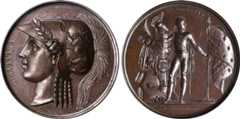
From Clinton’s Sixth Division, Colonel Coghlan ofthe 61st was killed. General Pack and Colonel Cuyler of the 11thand Colonels Douglas and Bermingham of the Portuguese army were wounded.
The 42nd Highlanders lost 26 officers and386 soldiers killed and wounded.
The 79th Highlanders lost 18 officers and215 soldiers killed and wounded out of a complement of under 500.
The 61st Regiment was brought out ofaction by the adjutant and 2 ensigns, all the more senior officers, except theadjutant, being killed or wounded.
From Picton’s Third Division: Colonel Forbes of the45th was killed and General Brisbane wounded in the disastrousattack on the Ponts Jumeaux.

Aftermathto the Battle of Toulouse:
Atnightfall on 11th April 1814, Soult’s army marched out of Toulouse,heading south-east towards Carcassonne, where Soult planned to join the army ofMarshal Suchet.

On 12thApril 1814, while both sides moved towards Carcassonne, news arrived from Parisof the abdication of the Emperor Napoleon and the end of the war.
On 18thApril 1814, Wellington and Soult signed an armistice and the fighting came toan end.
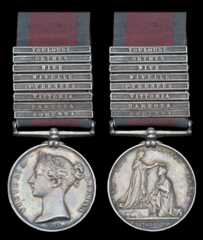
BattleHonours and Medal for the Battle of Toulouse:
The Military General Service Medal 1848 was issuedto all those serving in the British Army present at specified battles duringthe period 1793 to 1840 who were still alive in 1847 and applied for the medal.The medal was only issued to those entitled to one or more of the clasps. Therewere 21 clasps available for service in the Peninsular War.
The Battle of Toulouse was one of those clasps.
Medals were also struck privately to commemorate the Battle of Toulouse.
Battle honours were awarded to regiments for takingpart in certain important battles. The principal place for displaying aregiment’s battle honours is on the colours.
The Battle of Toulouse is a battle honour for the following British regiments: 5th Dragoon Guards, 3rd and 4th Dragoons, 13th Light Dragoons, 2nd Queen’s, 3rd Buffs, 5th, 7th Royal Fusiliers, 11th, 20th, 23rd Royal Welch Fusiliers, 27th, 28th, 36th, 40th, 42nd Black Watch, 43rd Light Infantry, 45th, 48th, 52nd Light Infantry, 53rd, 60th Rifles, 74th Highland Regiment, 79th Cameron Highlanders, 83rd, 87th, 88th Connaught Rangers, 91st Argyllshire Regiment, 94th and 95th Rifles.
The award of a battle honour seems not to have beengoverned by any particularly reliable benchmark. In some instances, regimentswere not given a battle honour when they were present and suffered casualties. Itis hard to see why the 18th Hussars were not given the battle honourof ‘Toulouse’.
Battle Honours and Medal for the Battle of Toulouse:
The Battle of Toulouse is a clasp on the 1848 MilitaryGeneral Service Medal and a battle honour for the following British regiments: 5thDragoon Guards, 3rd and 4th Dragoons, 13thLight Dragoons, 2nd Queen’s, 3rd Buffs, 5th, 7thRoyal Fusiliers, 11th, 20th, 23rd Royal WelchFusiliers, 27th, 28th, 36th, 39th,40th, 42nd Black Watch, 43rd Light Infantry, 45th,48th, 52nd Light Infantry, 53rd, 60thRifles, 74th Highland Regiment, 79th Cameron Highlanders,83rd, 87th, 88th Connaught Rangers, 91stArgyllshire, 94th and 95th Rifles.
The award of a battle honour seems not to have been governed by any particular benchmark. In some instances, regiments were not given a battle honour when they were present and suffered casualties. It is hard to see why the 18th Hussars were not given the battle honour of ‘Toulouse’.
Army Gold Medal:
In 1810 a Gold Medal was issued to be awarded to officers of rank of major and above for meritorious service at certain battles in the Peninsular War, with clasps for additional battles. The ‘Large Gold Medal’ was awarded to generals, the ‘Small Gold Medal’ to majors and colonels, with the medal replaced by a cross where four clasps were earned. The Battle of Toulouse was one of the battles.
Anecdotesand traditions from the Battle of Toulouse:
- As the British cavalry, infantry and guns crossed the pontoon bridge over the River Garonne on 5th April 1814, the regimental bands played‘The Fall of Paris’ to encourage the soldiers.
- While the pontoon bridge was in position on the River Garonne, downstream from Toulouse, the French sent trees and boats loaded with stones down the river, hoping to damage the pontoons. This was not achieved.
- The Battle of Toulouse was the first major battle at which the Royal Artillery used rockets in action, being fired at Taupin’s Division in the fighting over la Sypière redoubt. The rockets were fired by the Royal Artillery’s Mounted Rocket Corps, using rockets developed by Sir William Congreve from the weapons fired at the British during the Siege of Seringapatam in India in 1799 by Tipu Sultan’s army. Wellington heartily disliked the Congreve Rocket, considering it a waste of the Royal Artillery’s limited manpower resources, preferring guns. However, the British rocket was a much-feared weapon in Europe, credited with causing the Prussian and Russian Governments to bow to British pressure in the reconstitution of Europe.
- General John Brisbane, wounded leading his brigade in Picton’s rash attack on the Jumeaux bridges, later became governor of New South Wales in Australia. The town of Brisbane in Queensland is named after him.
- In the attack on the Mas des Augustins on the Heights of Calvinet the 42nd Black Watch were required by Colonel Macara to carry out an involved drill movement under the direct fire of French musketry and guns in order to bring the right wing of the regiment to the front before charging. The result was very heavy casualties to the regiment, causing one authority to comment‘in this fight the 42nd (Royal Highlanders) was well-nigh annihilated’.
- In October and November 1814, Lieutenant Colonel George Quentin, who commanded the 10th Prince of Wales’s Own Hussars at the Battle of Toulouse, was tried by court martial in London on charges inspired by his own officers arising from his conduct at the battle and on other occasions. Quentin was largely acquitted and exonerated by the King. The officers who brought the accusations against Quentin were threatened with dismissal and moved to other regiments.
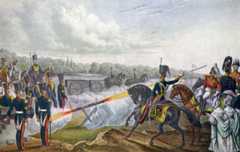
References for the Battle of Toulouse:
See the extensive list of references given at the end ofthe Peninsular War Index.
The previous battle of the Peninsular War isthe Battle of Tarbes
The next battle of the Peninsular War isthe Sortie from Bayonne
50.Podcast on theBattle of Toulousefought on 10th April 1814 by Wellington against Marshal Soult outside the French City of Toulouse in Southern France; the last battle fought by Wellington in the Peninsular War:John Mackenzie’s britishbattles.com podcasts




